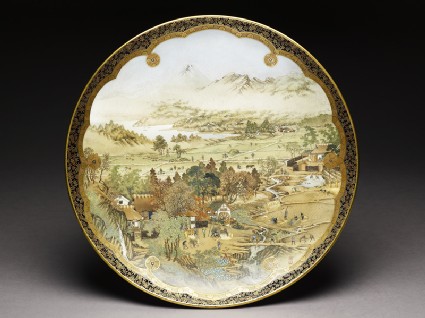Browse: 87 objects
- Reference URL
Actions
Kyo-Satsuma dish with landscape using westernized perspective
-
Details
- Associated place
-
Asia › Japan › Honshū › Kyōto prefecture › Kyoto (Kinkōzan kiln-site) (place of creation)Europe (probable original location)
- Date
- c. 1900
- Artist/maker
-
Kinkōzan Sōbei VII (1868 - 1927) (potter)Kinkōzan Workshop (active 1640s - 1920s)Itsuzan (active late 19th century - early 20th century) (artist)
- Material and technique
- earthenware, with underglaze painting in blue, and polychrome overglaze enamels, including gold
- Dimensions
-
5.5 cm (height)
36.7 cm (diameter)
- Material index
- Technique index
- Object type index
- No. of items
- 1
- Credit line
- Purchased with the assistance of the Story Fund, 1992.
- Accession no.
- EA1992.71
-
Further reading
Impey, Oliver, and Joyce Seaman, Japanese Decorative Arts of the Meiji Period 1868-1912, Ashmolean Handbooks (Oxford: Ashmolean Museum, 2005), no. 18 on p. 40, pp. 7 & 42, illus. pp. 40-41
Impey, Oliver, ‘Reflections upon the Arts and Crafts of Meiji Period Japan with Reference to the Collection of the Ashmolean Museum’, Oriental Art, 42/3, (Autumn 1996), p. 12, illus. p. 10 fig. 3
Glossary (2)
earthenware, underglaze painting
-
earthenware
Ceramic material made of clay which is fired to a temperature of c.1000-1200⁰c. The resulting ceramic is non-vitreous and varies in colour from dark red to yellow.
-
underglaze painting
Painting applied to ceramic material before a transparent, or monochrome or coloured glaze for Islamic objects, is applied. The technique was initially developed in China.
Location
Objects are sometimes moved to a different location. Our object location data is usually updated on a monthly basis. Contact the Jameel Study Centre if you are planning to visit the museum to see a particular object on display, or would like to arrange an appointment to see an object in our reserve collections.
Galleries
Collection trails
Publications online
-

Japanese Decorative Arts of the Meiji Period
Earthenware plate decorated with a landscape in westernized perspective, in detailed polychrome enamels with underglaze blue and gilding, within a lobed border. The image signed: Itsuzan. Signed under the base, a seal-mark in underglaze blue within a gold key fret border Kinkōzan zō. With an iron red seal: Chokusai. A further factory label in English.
The Kinkōzan factory was an old one, having made Kyō-yaki for several generations. The sixth generation master, modernized the Kyōto factory, specializing in high quality Satsuma-style decorated wares. His son, Sōbei VII (1868-1927), succeeded his father in 1884. In this fairly typical plate, of excellent quality, it is interesting to see how the painter (presumably Itsuzan) has not quite understood European geometric perspective, for though there is recession vertically, there is no fixed viewpoint, and the eye is always at a right-angle to the horizontal area, just as if viewing a Japanese screen.
© 2013 University of Oxford - Ashmolean Museum












